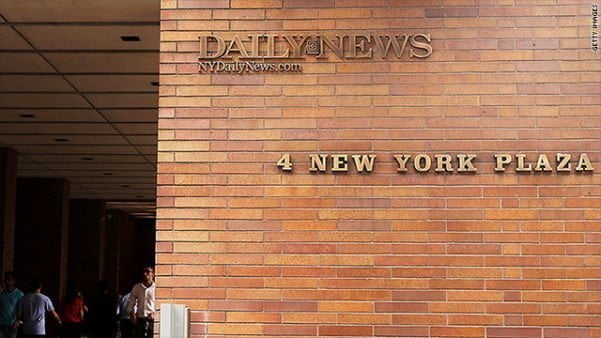“I’m as mad as hell and I’m not going to take this anymore!”
Remember that line? It was uttered in the movie “Network” by Howard Beale and went on to become a popular movie drop used on many radio stations in their imaging. It also describes the feeling many in our business have when they see reports surface of another mass layoff by a large media company.
Last week, the New York Daily News lost its heartbeat when it pulled the plug on forty five of its best and brightest people. One section which was especially hit hard was the sports section which had become part of the fabric of New York sports coverage for decades.
When I heard the news, I was irate. Seeing talented individuals lose their jobs due to the incompetence of ownership is frustrating. Frank Isola, John Harper, and Peter Botte, to name a few, showed up every day for decades, excelling at their craft. They were exceptional sports writers who provided superb content, and were one of the few reasons I still read my hometown newspaper. But now due to executive ignorance, and bad business decisions, their efforts and loyalty have been rewarded with a pink slip and a mention in a corporate press release thanking them for their years of service.
After the Daily News gutted their newsroom, many personalities took to Twitter to voice their displeasure with the situation. Everyone from Michael Kay to Tony Reali to New York Governor Andrew Cuomo fired shots at Tronc, the parent company of the News, demanding answers for the exodus. Though I share their hostility for the recent turn of events, and will no longer invest one single second reading the Daily News’ content, I can’t help but wonder if this is the new normal for the media business.
Think about it, the New York Daily News, a staple of consistency, has now been torn apart from the inside out. ESPN, a company which seemed safeguarded from any kind of bloodletting, endured mass layoffs twice in the past few years. Rogers Communications and Bell Media, two successful companies in Canada, both eliminated hundreds of jobs in the past few years. Vox Media, BuzzFeed, and Meredith Corp., the company which bought Time, Sports Illustrated, Fortune, and Money, also reduced their work forces.
It leaves you with a sour taste in your mouth, but also makes you realize that operating in today’s world is very different. If a company doesn’t stay ahead of the curve, and find ways to reinvent its business model, they soon pay the price for falling behind, regardless of how successful or important they’ve been to their customer’s lives.
As I began writing this piece, I started reflecting on brands that were once important to me but have since decreased in value. Coincidentally, a number of those companies have either gone out of business or been severely altered. In some ways, I and those of you reading this who think like me, share in the blame for their demise. If we don’t continue supporting businesses, they lose money. When they lose money, jobs are lost. If expenses continue to outweigh profitability, larger decisions about a company’s future are explored.
I grew up on Toys R Us. It was my favorite store in the world as a kid. After I became an adult, the store had less value. That connection was restored when I became a father, but even then, the amount of business I did with the store compared to what I and my father did when I was a kid was drastically less.
When I was younger, the option to order merchandise on my phone and have it arrive at my door the next day didn’t exist. Had it been a possibility, I might never have discovered the charm of going into a Toys R Us. I was disappointed when I heard the store was shutting its doors in late June, but I then recalled how many times I had ordered toys for my son online, and quickly understood why.
In my teenage and early adult years, I practically lived at Blockbuster Video. I loved going into that store, buying a bucket of popcorn, and finding the latest movie rentals. It was a great family experience. But once television began offering On-Demand video, and groups like Netflix launched with superior offerings, those trips to Blockbuster stopped. The video rental chain was even given a chance to survive when Netflix offered to sell to them for $50 million dollars, but they botched that too. Netflix is now worth nearly $150 billion dollars.
Throughout my life, music has been a big part of my enjoyment. I’ve consistently supported artists by purchasing hundreds of singles and albums, and because I did, stores like FYE, Tower Records, Sam Goody, and Strawberries earned a lot from my paychecks. Once Napster launched and made file sharing possible, many started buying less records. Then as Apple, Spotify and Amazon made larger investments in offering music, the need to go buy a CD became minimal.
If you drive to most towns in America today, most of these stores barely exist. WalMart, Target, and a handful of others still sell music, but the selections are thin. The majority of music purchasing now takes place online, and although I still like to buy a CD at the store every now and then, I do it far less than I used to.
Having things appear on our phones, television screens, and doorsteps, has changed the consumer experience for the better. We still have interest in many of the same products, but our needs are different. We want things quickly, conveniently, and affordably. The idea of driving to stores, standing in lines, and paying higher prices is a thing of the past. It may sadden us to see some places exit the retail world that were once important to us, but when brand’s fail to adapt to a rapidly changing business environment, that can happen.
Which brings me to the radio business.
What Toys R Us, Blockbuster Video, and the NY Daily News have experienced is what could also face the radio industry in the future if it doesn’t evolve. The content will of course remain vital regardless of which era it’s offered in, but what about the way radio features advertising? Do you honestly think businesses are going to occupy fifteen minutes per hour on radio stations in between songs or talk content down the line?
Take a look around the world. TV networks have begun reducing their inventory. Why? They know people won’t sit thru long stretches of commercials. Advertisers know it too and don’t want to spend money just to be tuned out. That’s especially the case when viewers watch on-demand programming. They take their DVR, and immediately fast forward past the commercials to continue watching their favorite shows thus making it extremely difficult for the advertiser to reach them.
Check out YouTube. Their audience sizes are huge, and they realize that ads running 15 seconds or less are their only chance to keep people on the platform. Once longer commercials are pushed towards the viewer, they vanish. If offered in small doses though, fans of the content will sit thru it. The company has especially seen great results pushing six second ads.
Since I became a YouTube TV and Roku subscriber, I’ve learned how their approach works. The programming options are endless, and the video quality is exceptional, but if there’s a downside, it’s that when recorded shows air, the viewer is forced to sit thru a commercial break. The breaks are still shorter than what you receive on normal television, but even a one-minute spot break feels like an eternity when you’re watching a recorded show and trying to skip ahead to the next part of the content. At some point I’d expect that to change, but even if the breaks remained :30-:60 seconds, I think most people would accept it if it meant keeping costs low and content quality high.
So where does that leave radio? How exactly do you replace 15-20 minutes of spots per hour, and various inclusions in content (sports updates, traffic reports, weather updates, stock reports, etc.), and still remain profitable?
You could try to charge the audience to listen, but that’s a tall order. You could raise your rates for the limited amount of ad time inside your programming, and that’ll work with some clients, but not with all. It’s easy to suggest reducing ad times on stations because of audience demand, but how exactly do you replenish all that lost income?
We could investigate the possibility of further monetizing social media, podcasts, apps, and smart speakers, and although they’re all important to our business growth, if we’re not excelling in these spaces now, why would you expect them to be areas we’d dominate in down the line? Other opportunities will revolve around some of the things we do now such as creating events, and producing branded content. We’ll also have to become retailers, using our platforms to sell custom merchandise and products created by partners who we share revenue with.
Remember, most of the areas that we play in, belong to someone else. Facebook, Twitter, Apple, and Google own the property, we just rent it. 5 years ago Facebook began limiting the ability of a brand to reach its entire audience. Think they won’t do that again? As soon as they see you reaping the rewards from utilizing their platform, they’re going to put up more roadblocks to take more money out of your pocket.
Keep that in mind as you’re falling deeper in love with the Amazon Alexa and Google Home. Those devices are great, and give our fans a chance to hear our content without interruptions. But do you think Amazon and Google won’t eliminate your ads in the future and serve their own up to your audience? Do you honestly believe they wouldn’t do to your brand what Facebook did, and force you to spend money to reach your listeners? As they gain more momentum, do you think they’re going to make it easy on you to access and use your data however you see fit?
A few other things you need to ask yourself, if the business model is going to change that drastically, how will that help with attracting future sellers? Is a new seller going to want to sell audio instead of Facebook, Google, Twitter or Amazon? Will a new salesperson see a better financial path to success selling audio or video? What about our current sellers who rely on selling radio ad time to make a living? If they see limited potential right now earning a living selling apps, podcasts, social media, and your brand’s website, why would they put their focus in that space when it doesn’t pay the bills?
What’s really going to be important is the measurement of our performance in these other locations, and our ability to educate advertisers on the way our programming can help them generate results. If our brands are well established, and the talent we employ possess the skill to mentally own space inside the listener’s mind, then we’ll still have a chance to gain support and trust from local and national business partners.
Perhaps the bigger challenge is going to be for programmers and content creators, because there might come a time when shows aren’t taking commercial breaks. Picture HBO programming where the movie never ends. Your breaks would come in the form of vignettes, liners, airing of soundbites, taped interviews, etc. In other words, following the content model of podcasts, and SiriusXM which reward the user and limit the interruptions.
That could also lead to shows being shorter in length too. If the average metered listener consumes your programming for 30-45 minutes per occasion, are you better served with one 4-hour show or two 2-hour shows? Some could even make a case for four 1-hour shows.
If breaks were someday to be done away with, advertisers would have to be further woven into the content without it seeming forced. If we hope to compete with other media for dollars and listeners, we’re going to need a less is more mindset, and give clients an opportunity to be more intertwined into specific programming. Movies and TV shows have done a great job of including brands into their content, and it’s a space where radio can step its game up. Barstool Sports and Bleacher Report, two relatively newer brands (under 20 years in operation), have figured out how to excel at it. Radio with its rich history should be able to do the same.
Change is inevitable in every business. Whether it’s complicated or not, technology creates it, audiences demand it, and dollars follow it. If we want to avoid future dark days where our best people lose opportunities and serve as reminders of our failure to read the signs and modify the way we approach our business, then we’ve got to get out in front of these issues rather than waiting them to arrive on our doorstep. When habits change, you either adapt, or get rendered obsolete. The winds of change wait for no one.

Jason Barrett is the President and Founder of Barrett Media since the company was created in September 2015. Prior to its arrival, JB served as a sports radio programmer, launching brands such as 95.7 The Game in San Francisco, and 101 ESPN in St. Louis. He also spent time programming SportsTalk 950 in Philadelphia, 590 The Fan KFNS in St. Louis, and ESPN 1340/1390 in Poughkeepsie, NY. Jason also worked on-air and behind the scenes in local radio at 101.5 WPDH, WTBQ 1110AM, and WPYX 106.5. He also spent two years on the national stage, producing radio shows for ESPN Radio in Bristol, CT. Among them included the Dan Patrick Show, and GameNight.
You can find JB on Twitter @SportsRadioPD. He’s also reachable by email at Jason@BarrettMedia.com.








Very well researched, Jason. I own a multimedia news agency in Buffalo area called wnynewsnow.com. We produce and air a live show everyday called “New and Noteworthy.” When I say “aired” I mean on FB live. Our company has garnered 13,000 likes in 16 months. With that said, I’ve discovered that I can monetize the show by using FB analytics to act as PPM #’s. In a non-rated market (Jamestown NY) I have forced 7 radio stations and a newspaper to acknowledge the agency’s worth. We took $30,000 from those outlets last year by employing the strategy you suggested in this article.